Blackpool, Lancashire, England, UK – Monday, June 21st, 2010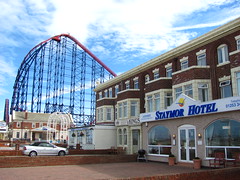
“It’s great to finally be here and see the Big One in person after hearing about it for so long,” I told the proprietor of the hotel which stood barely 200 meters from the first drop. In that moment I meant what I said honestly, as it seemed a little unreal to see that singular roller coaster profile without the invisible barrier of pixels or print between me and it. Blackpool Pleasure Beach was one of the first overseas amusement parks I had ever heard of, the Big One having appearances all of my original roller coaster books and VHS tapes for being the tallest roller coaster in the world when I first began delving into the hobby around 1995. Even as recently as when I entered college I would have ranked Blackpool as being the number one amusement park anywhere in the world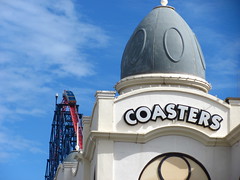 I wanted to visit, probably because the large scale and coastal setting mixed with an array of quirky, older rides (and one of the earliest hypercoasters by Arrow) in an authentically eclectic historical setting seemed to combine the best features of two American parks near and dear to my heart; Cedar Point and Kennywood.
I wanted to visit, probably because the large scale and coastal setting mixed with an array of quirky, older rides (and one of the earliest hypercoasters by Arrow) in an authentically eclectic historical setting seemed to combine the best features of two American parks near and dear to my heart; Cedar Point and Kennywood.
My expectations of Pleasure Beach cooled some in recent years when I read more and more about questionable operations and managerial practices that suggested the electric boardwalk atmosphere I had been expecting was replaced with something more drab and depressing (the fact that the park rarely stays open after dark contributes to this perception in a literal way, as the electricity is never turned on). 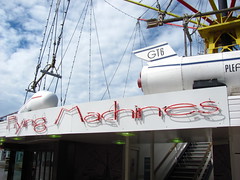 I also had to question whether any single attraction would make my list of favorites, especially as they seem to have stagnated in building new, worthwhile rides around the time they started calling themselves “Pleasure Beach, Blackpool” (which for historical, moral and cataloguing purposes I deliberately refused to call as well on this website). Part of me couldn’t wait to enter their gates, the other part of me was afraid to do so after all these years of anticipation.
I also had to question whether any single attraction would make my list of favorites, especially as they seem to have stagnated in building new, worthwhile rides around the time they started calling themselves “Pleasure Beach, Blackpool” (which for historical, moral and cataloguing purposes I deliberately refused to call as well on this website). Part of me couldn’t wait to enter their gates, the other part of me was afraid to do so after all these years of anticipation.
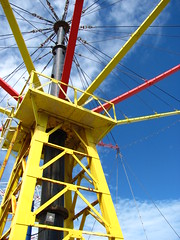 My first ride seemed to dispel many of these anxieties; the Flying Machines are a downright retro contraption kept in an immaculately clean condition. It’s Pleasure Beach’s oldest ride dating from 1904, and it seems to have been renovated with plenty of chrome and art-deco flourishes sometime a few decades later which it still sports to this day, located on a pad above a similarly styled gift and coffee shop. This isn’t one you really ride for thrills, as it’s an extremely gentle gyration above the midway in heavy metallic rockets that pack plenty of inertia, producing a steady grace I don’t normally get out of cable-suspended swing rides. It’s interesting to consider how people originally would have experienced this ‘thrill ride’ over 100 years ago, and how perceptions have changed with the times. Apart from the historical kitsch value, it provides an excellent panorama of the amusement park landscape making it an excellent first attraction for anyone new to Blackpool.
My first ride seemed to dispel many of these anxieties; the Flying Machines are a downright retro contraption kept in an immaculately clean condition. It’s Pleasure Beach’s oldest ride dating from 1904, and it seems to have been renovated with plenty of chrome and art-deco flourishes sometime a few decades later which it still sports to this day, located on a pad above a similarly styled gift and coffee shop. This isn’t one you really ride for thrills, as it’s an extremely gentle gyration above the midway in heavy metallic rockets that pack plenty of inertia, producing a steady grace I don’t normally get out of cable-suspended swing rides. It’s interesting to consider how people originally would have experienced this ‘thrill ride’ over 100 years ago, and how perceptions have changed with the times. Apart from the historical kitsch value, it provides an excellent panorama of the amusement park landscape making it an excellent first attraction for anyone new to Blackpool.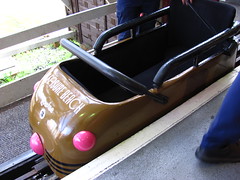
While the Flying Machines were a good introduction to Pleasure Beach, nothing could have prepared me for the Wild Mouse. The English language lacks sufficient descriptors that accurately communicate the ideas at play. It is beyond genre categorization as other wild mice. It is not a narrative ride that sequences elements to progress to a logical conclusion. Forces are quite present but not the defining characteristic. Rational discourse is powerless to explain what makes the Wild Mouse such an addictive roller coaster using the standard analytic lexicon of this web project.
What the “Wild Mouse” is, is being a body sitting in a small car not many factors heavier than its rider that is flung around a narrow track on squealing metal wheels through a wooden scaffolding frame while gravity and other contributing forces to the vehicles’ velocity do not result in a predetermined rider experience immune from factors of chance resulting in a uniquely specific ride never to be perfectly duplicated again in history. That’s a bit too long of a ride description to fit on the information sign in the queue so I’ll instead call it “a roller coaster seating passengers in individual mouse-shaped cars with sharp drops and fast turns”.
around a narrow track on squealing metal wheels through a wooden scaffolding frame while gravity and other contributing forces to the vehicles’ velocity do not result in a predetermined rider experience immune from factors of chance resulting in a uniquely specific ride never to be perfectly duplicated again in history. That’s a bit too long of a ride description to fit on the information sign in the queue so I’ll instead call it “a roller coaster seating passengers in individual mouse-shaped cars with sharp drops and fast turns”.
It lacks the standard progression of high switchback turns followed with a series of drops in favor of a varied assortment of turns and drops that can’t be guessed in advance until you’re familiar with this particular layout. There are a few switchback turns in the middle of the ride, although the 90° box turns that follow are much harsher. Much has already been commented by fans of Blackpool’s Mouse over how forceful the experience is. These lateral turns are brutal, some more so than others. This inequality delivered a slightly terrifying prospect on rerides after slamming around in one of the early switchbacks too hard and realizing that the next one was to be even more intense. “There’s no avoiding it now, just try not to think about it too much before it happens,” slightly hard not to do when there’s nothing but a long straight piece of track
just try not to think about it too much before it happens,” slightly hard not to do when there’s nothing but a long straight piece of track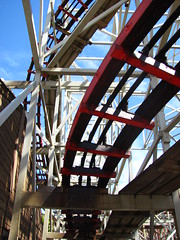 anticipating the next near-lethal bend. There is much airtime (both floater and ejector) on many of the drops, which I would argue are of superior quality to most modern coaster airtime due to the absence of anything save for a loose-fitting seat-belt to hold you in.
anticipating the next near-lethal bend. There is much airtime (both floater and ejector) on many of the drops, which I would argue are of superior quality to most modern coaster airtime due to the absence of anything save for a loose-fitting seat-belt to hold you in.
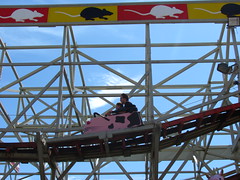 For me what made the Wild Mouse so addictively rerideable was the sense that I could change the outcome of these forces at any moment by adjusting how I was seated. I wasn’t sure if this was because depending on how you sit your body absorbs and reacts to the forces differently, or if it actually did alter the momentum of the little mouse vehicles. I would expect it’s more a result of the former (sometime a turn would nearly induce whiplash while other times I would slide into it more smoothly, indicating I had perhaps positioned myself to better anticipate it),
For me what made the Wild Mouse so addictively rerideable was the sense that I could change the outcome of these forces at any moment by adjusting how I was seated. I wasn’t sure if this was because depending on how you sit your body absorbs and reacts to the forces differently, or if it actually did alter the momentum of the little mouse vehicles. I would expect it’s more a result of the former (sometime a turn would nearly induce whiplash while other times I would slide into it more smoothly, indicating I had perhaps positioned myself to better anticipate it), but I can’t help think the latter has some validity to it as well (some hills, notably the very last dip, would produce huge airtime on some rides and not much on others; perhaps which of the several cars running the track I had also contributed to the difference).
but I can’t help think the latter has some validity to it as well (some hills, notably the very last dip, would produce huge airtime on some rides and not much on others; perhaps which of the several cars running the track I had also contributed to the difference).
This always meant that once was never enough. The Wild Mouse had to be sampled at least three or four times before moving on, and I would always be back later anyway. There was the mystery of not knowing exactly what the ride in my immediate future would provide, and the excitement of knowing that it was partly owing to my own freedom to influence what that ride would be. I can’t think of many other rides that have such a high degree of ‘interactivity’ allowing for minor variations even after you’ve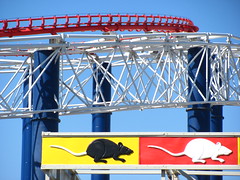 chosen your seat and have departed the station.
chosen your seat and have departed the station.
In the end though it was probably just because the Wild Mouse is so unique and has so much personality to it that it simply had to be visited many, many times in order to catalogue all of its quirks and eccentricities (like being able to touch the underside of another overhead section of track whilst going up the lift). For such a ubiquitous coaster genre that often goes completely unnoticed by enthusiast communities, I surprise myself whenever I count how many wild mice I would label as ‘great rides’ that are highlight attractions at their respective parks. Many of these are funky classics that might even predate the introduction of the ‘official’ tubular steel roller coasters, but there have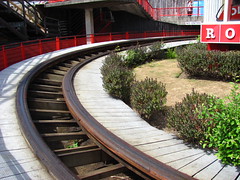 been some winners in modern times as well (mostly those that combine dark ride elements). Blackpool’s Wild Mouse, the first wooden variant I have ever been on, takes the cake as the first and only of its class that I would rank in my top 25 Essentials.
been some winners in modern times as well (mostly those that combine dark ride elements). Blackpool’s Wild Mouse, the first wooden variant I have ever been on, takes the cake as the first and only of its class that I would rank in my top 25 Essentials.
As a fan of the ‘classics’, I’m always a bit annoyed when others compare them to modern rides using a vocabulary of contemporary criteria from which they deduce my old-time favorite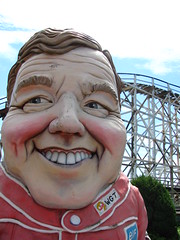 are generally not as good as those being built today. I’d like much to reply that they ‘just don’t understand’ the appeal of the oldies but this sounds trite and like I’m trying to cover up for an unsubstantiated bias founded exclusively on nostalgia. How can I even be nostalgic about these rides when the first time I’ve ever ridden them is today? Blackpool does a good job of showing why a bias for the classics can be justified depending on your tastes: you simply can’t find anything like it anywhere else around the world. Even the best coasters today are fairly standardized products that you can find familiar instances of elsewhere, but the only similarity the rides from yesterday all share is they each have their own unique, individual, sometimes humorous solutions to engineering. Assuming one has an interest in how these contraptions work beyond just the immediate experience they give, these observations should play a role in one’s overall assessment.
are generally not as good as those being built today. I’d like much to reply that they ‘just don’t understand’ the appeal of the oldies but this sounds trite and like I’m trying to cover up for an unsubstantiated bias founded exclusively on nostalgia. How can I even be nostalgic about these rides when the first time I’ve ever ridden them is today? Blackpool does a good job of showing why a bias for the classics can be justified depending on your tastes: you simply can’t find anything like it anywhere else around the world. Even the best coasters today are fairly standardized products that you can find familiar instances of elsewhere, but the only similarity the rides from yesterday all share is they each have their own unique, individual, sometimes humorous solutions to engineering. Assuming one has an interest in how these contraptions work beyond just the immediate experience they give, these observations should play a role in one’s overall assessment.
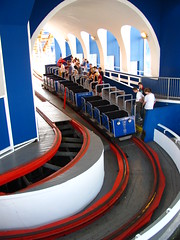 This is most definitely to the Big Dipper’s advantage, a ride I found utterly intoxicating as a historical curiosity, even though as a ride experience I found it to be rather weak. The station is a beautiful, open-air archway with equal art-deco and seaside inspiration, tucked beneath the top turnaround from the main hill (itself supported by diagonal iron lattice girders with a decorative centerpiece on top rather than the normal wooden supports). The train looks like an ordinary PTC at first but on closer inspection is revealed to have four rows per car with taller seat walls and a heavier build, headlights on front and (of course!) single-position lapbars holding us inside.
This is most definitely to the Big Dipper’s advantage, a ride I found utterly intoxicating as a historical curiosity, even though as a ride experience I found it to be rather weak. The station is a beautiful, open-air archway with equal art-deco and seaside inspiration, tucked beneath the top turnaround from the main hill (itself supported by diagonal iron lattice girders with a decorative centerpiece on top rather than the normal wooden supports). The train looks like an ordinary PTC at first but on closer inspection is revealed to have four rows per car with taller seat walls and a heavier build, headlights on front and (of course!) single-position lapbars holding us inside.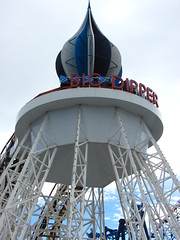
Once the brakes are thrown we roll out of the station by curving underneath it, and the curve is of a shockingly tight radius considering we’ve got these lumbering four-seater cars trying to navigate it. How does it do it? I was able to get a good look and found that the greased wheels basically slide across the steel rails at a nearly perpendicular angle. There’s a shallow, mini-lift hill at the other end of the tunnel approached over a curve and comes very close to the opposing track above it. (Ever wondered what a wooden coaster’s chain lift sounds like without any anti-rollbacks? Ride the Big Dipper to find out!) After doubling back over for the main lift hill, the turnaround at the top is even tighter than the one out of the station; I might have imagined the Gravity Group’s Timberliners capable of navigating such a sharp turn, but not much else, certainly not these monstrosities.
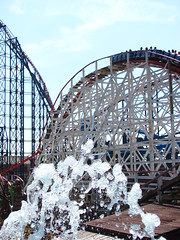 Sadly, once the action gets going the ride somehow manages to get less interesting. The Dipper tracks reasonably smoothly but I think the heavy cars have been taking a toll on some of the high speed pull ups. The first few hills seem like they should offer lots of airtime but this is mostly absent.
Sadly, once the action gets going the ride somehow manages to get less interesting. The Dipper tracks reasonably smoothly but I think the heavy cars have been taking a toll on some of the high speed pull ups. The first few hills seem like they should offer lots of airtime but this is mostly absent. They have an odd profile to them, seemingly the opposite of the standard parabolic shape. They’re the tightest at the entry and exit with a wider, gentle crown over the very top when speed is the lowest. This means seats in the very front or back will get a boost of sudden airtime, but if you grabbed a quick walk-on row somewhere in the middle the experience may underwhelm.
They have an odd profile to them, seemingly the opposite of the standard parabolic shape. They’re the tightest at the entry and exit with a wider, gentle crown over the very top when speed is the lowest. This means seats in the very front or back will get a boost of sudden airtime, but if you grabbed a quick walk-on row somewhere in the middle the experience may underwhelm.
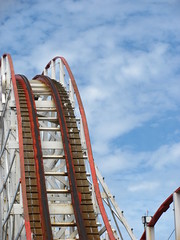 After a few hills there’s a very wide, undulating turnaround near the Big Blue Hotel, Big One’s midcourse and underneath the Steeplechase. A lower height gives it the distinction of having a much faster clip through the mandatory turnaround maneuver, although the wide berth means it perhaps overstays its welcome when what we’re really chasing after are more classic airtime hills. The thrills momentarily picks up with a sudden drop beneath a pathway, followed by two shallow, curving dips, and finishing with two last hops somewhere in between. I return to the station having really liked the Big Dipper despite finding it not quite as enjoyable as an out-and-back of its generation should have been.
After a few hills there’s a very wide, undulating turnaround near the Big Blue Hotel, Big One’s midcourse and underneath the Steeplechase. A lower height gives it the distinction of having a much faster clip through the mandatory turnaround maneuver, although the wide berth means it perhaps overstays its welcome when what we’re really chasing after are more classic airtime hills. The thrills momentarily picks up with a sudden drop beneath a pathway, followed by two shallow, curving dips, and finishing with two last hops somewhere in between. I return to the station having really liked the Big Dipper despite finding it not quite as enjoyable as an out-and-back of its generation should have been.
Smaller and cuter, the 1933-build children’s wooden coaster Zipper Dipper awaited my arrival at the back of Beaver Creek. I don’t believe I’ve ever ridden a smaller woodie (sorry I couldn’t think of a better way to phrase that; I had to be careful with the name of the children’s area as well to prevent unintentional innuendo). The layout is best characterized as ‘half an out-and-back’, so I guess it’s just a ‘back’.
‘half an out-and-back’, so I guess it’s just a ‘back’.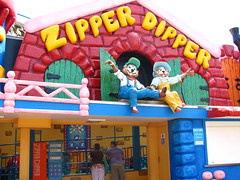 The brake run, station and lift make up one leg of the journey, with three very shallow drops comprising the other, the primary thrill generated pretty much from the faint sensation of acceleration and traveling at a speed slightly faster than we’re accustomed to walking when we’re late for our dental appointment. I imagine the people that fainted during the first screening of the Great Train Robbery would be blowing air out of the corner of their lips after this. In other words, it’s perfect, and when asked by the operator if I wanted a second ride, the response from its sole participant was an unhesitating “Yes!”
The brake run, station and lift make up one leg of the journey, with three very shallow drops comprising the other, the primary thrill generated pretty much from the faint sensation of acceleration and traveling at a speed slightly faster than we’re accustomed to walking when we’re late for our dental appointment. I imagine the people that fainted during the first screening of the Great Train Robbery would be blowing air out of the corner of their lips after this. In other words, it’s perfect, and when asked by the operator if I wanted a second ride, the response from its sole participant was an unhesitating “Yes!”
Sadly, the nearby Roller Coaster (love that they’ve kept that name all these years!) was out of commission for the entirety of my stay, although my loss was not entirely in vain as they were actively using this downtime to replace and maintain sections of track. It looks like a smaller version of the Big Dipper, sans the strange engineering before the first drop but with a wonderfully vibrant red and yellow clamshell ceiling inside the station. A train similar to those on the Big Dipper and Grand National sat silently in its station, and the original streamlined, restraintless train waited nearby on the transfer (these need to switch places when it reopens!) I’ve heard that the chances of riding both the Roller Coaster and the Big Dipper on the same day would have been rather slim anyway, as there are too many rides at Blackpool relative to the average attendance numbers and so the Roller Coaster is a backup for whenever the Big Dipper is down. Perhaps that will change next season when the area becomes revitalized as Nickelodeon Land, but that brings up an entirely different issue:
Seriously, what the hell?
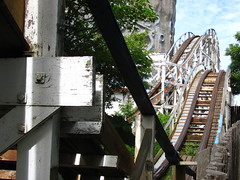 Okay, okay, so it’s a big expansion for Pleasure Beach that it needs after a decade of second-rate investments, and I realize that historical preservationist tendencies shouldn’t come at the hindrance of modern innovators. I would be among the first to applaud Blackpool’s move to revitalize an aging section of their park because part of the charm of these eclectic seaside parks is that you get a mishmash of attractions from every decade over the past hundred years standing side-by-side. The spirit of the Pleasure Beach of old was the constant search of the latest and greatest sights and sounds known to mankind, and it would be a disservice to that legacy to let it fall into obsolescence just to please traditionalists such as (admittedly) myself. I thought Beaver Creek was a charming, uniquely British little children’s grotto,
Okay, okay, so it’s a big expansion for Pleasure Beach that it needs after a decade of second-rate investments, and I realize that historical preservationist tendencies shouldn’t come at the hindrance of modern innovators. I would be among the first to applaud Blackpool’s move to revitalize an aging section of their park because part of the charm of these eclectic seaside parks is that you get a mishmash of attractions from every decade over the past hundred years standing side-by-side. The spirit of the Pleasure Beach of old was the constant search of the latest and greatest sights and sounds known to mankind, and it would be a disservice to that legacy to let it fall into obsolescence just to please traditionalists such as (admittedly) myself. I thought Beaver Creek was a charming, uniquely British little children’s grotto,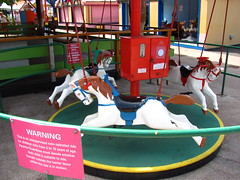 it probably wouldn’t have been my first pick of areas in the park that needed a fixer-upper, but if that’s what management had in mind for their next big then who am I to stand in the way of progress, especially when it involves not the destruction but the reimagining of the two true classics? The absence of any crowds today speaks for itself.
it probably wouldn’t have been my first pick of areas in the park that needed a fixer-upper, but if that’s what management had in mind for their next big then who am I to stand in the way of progress, especially when it involves not the destruction but the reimagining of the two true classics? The absence of any crowds today speaks for itself.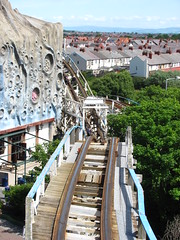
This argument was delegitimized as soon as “Nickelodeon” entered the picture. I am humbly of the opinion that such international franchises have absolutely no right come within 500 yards of a traditional amusement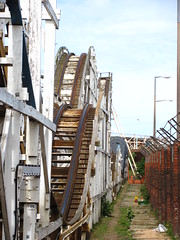 park like Pleasure Beach, much less replace or ‘retheme’ a number of traditional rides and attractions. Blackpool has its own identity which they seem to be selling off by the pound. This land belongs under the banner of an American chain park company building next to a mall or something, not in a place like Pleasure Beach. I didn’t see anything from those plans that didn’t appear like they got the blueprints on the cheap after Cedar Fair dumped the licensing agreement from the Paramount Parks, and the rides seem to be taken from the Disney mentality of flat rides, which is to build small or boring attractions that are dressed up to look expensive, and then watch the crowds flock. The Avatar Airbender looks identical to the Kings Island ride but they ordered a smaller Disk’O version, and the world needs another Disk’O like it needs another twist ending M. Night Shyamalan film.
park like Pleasure Beach, much less replace or ‘retheme’ a number of traditional rides and attractions. Blackpool has its own identity which they seem to be selling off by the pound. This land belongs under the banner of an American chain park company building next to a mall or something, not in a place like Pleasure Beach. I didn’t see anything from those plans that didn’t appear like they got the blueprints on the cheap after Cedar Fair dumped the licensing agreement from the Paramount Parks, and the rides seem to be taken from the Disney mentality of flat rides, which is to build small or boring attractions that are dressed up to look expensive, and then watch the crowds flock. The Avatar Airbender looks identical to the Kings Island ride but they ordered a smaller Disk’O version, and the world needs another Disk’O like it needs another twist ending M. Night Shyamalan film.
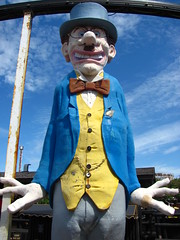 I suspect the reason this annoys me so greatly might not be felt as much by local fans, which is that I’ve already seen this exact same thing in America, and that is precisely the reason why I bothered to leave home in the first place. Assuming it carries any of the same atmosphere as the old Nick zone at Kings Island did, I will swear up and down that when opening day comes this place will not feel right. A Nickelodeon Land has a singular set of blueprints, Pleasure Beach does not. The themeing requires a positive relationship of ‘attention to detail’ with ‘enjoyablity’, while Pleasure Beach’s scattered attempts at themeing are made better when they appear homemade and hand painted. Nickelodeon has appeal because we’re already familiar with the brand, Pleasure Beach has appeal because there is still a mystery around the next corner. The bright, solid color palette of Nick Land has a crippling fear of the weathering from a salty sea air, while Pleasure Beach welcomes Mother Nature to put the final coat of paint the human painters forgot to add. It’s not that Nickelodeon Land in the abstract is a bad idea;
I suspect the reason this annoys me so greatly might not be felt as much by local fans, which is that I’ve already seen this exact same thing in America, and that is precisely the reason why I bothered to leave home in the first place. Assuming it carries any of the same atmosphere as the old Nick zone at Kings Island did, I will swear up and down that when opening day comes this place will not feel right. A Nickelodeon Land has a singular set of blueprints, Pleasure Beach does not. The themeing requires a positive relationship of ‘attention to detail’ with ‘enjoyablity’, while Pleasure Beach’s scattered attempts at themeing are made better when they appear homemade and hand painted. Nickelodeon has appeal because we’re already familiar with the brand, Pleasure Beach has appeal because there is still a mystery around the next corner. The bright, solid color palette of Nick Land has a crippling fear of the weathering from a salty sea air, while Pleasure Beach welcomes Mother Nature to put the final coat of paint the human painters forgot to add. It’s not that Nickelodeon Land in the abstract is a bad idea;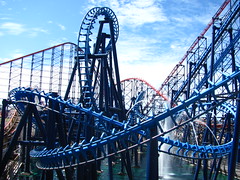 it’s simply that it isn’t Blackpool Pleasure Beach.
it’s simply that it isn’t Blackpool Pleasure Beach.
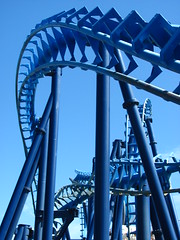 The best that I can say for Nickelodeon Land is that it makes Infusion seem a wiser addition in comparison. I’ll start the review by noting that the worst thing I’ll have to say about Infusion is that is still stings of the memory of the sudden closure of Pleasureland Southport in 2006 that left the only pre-1970’s traditional (non-scenic railway) roller coaster in Europe outside of Blackpool at the business end of a bulldozer. Even though I have more favorable opinions of the average SLC than many others have, there is only so much one can take of this breed before the burnout effect starts to take hold. I especially would have hoped that after so much time since their last roller coaster (Pepsi Max Big One back in 1994), they would have done much better than a used SLC, although this genre
The best that I can say for Nickelodeon Land is that it makes Infusion seem a wiser addition in comparison. I’ll start the review by noting that the worst thing I’ll have to say about Infusion is that is still stings of the memory of the sudden closure of Pleasureland Southport in 2006 that left the only pre-1970’s traditional (non-scenic railway) roller coaster in Europe outside of Blackpool at the business end of a bulldozer. Even though I have more favorable opinions of the average SLC than many others have, there is only so much one can take of this breed before the burnout effect starts to take hold. I especially would have hoped that after so much time since their last roller coaster (Pepsi Max Big One back in 1994), they would have done much better than a used SLC, although this genre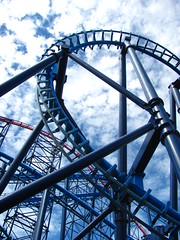 does seem suited to Blackpool: an inverted steel looping coaster is a logical intermediary between the Big One and Revolution, the park’s only other two steel thrill rides. That it fits the plot of land between the Big One and Big Dipper like it had been intended that way all along is another factor (unfortunately) weighing in the ride’s favor for relocation to Pleasure Beach. Even the presentation makes sense. It’s a contemporary aesthetic with the deep, bold blue palate (using the Big One’s thick support structure for enhancement), and all manner of decorative fountains and water features sprouting off the sides, including a neat water ramp below the third inversion. This is the sort of look that I would be talking about when I speak of the historical eclecticism representing every decade found within Pleasure Beach’s domain.
does seem suited to Blackpool: an inverted steel looping coaster is a logical intermediary between the Big One and Revolution, the park’s only other two steel thrill rides. That it fits the plot of land between the Big One and Big Dipper like it had been intended that way all along is another factor (unfortunately) weighing in the ride’s favor for relocation to Pleasure Beach. Even the presentation makes sense. It’s a contemporary aesthetic with the deep, bold blue palate (using the Big One’s thick support structure for enhancement), and all manner of decorative fountains and water features sprouting off the sides, including a neat water ramp below the third inversion. This is the sort of look that I would be talking about when I speak of the historical eclecticism representing every decade found within Pleasure Beach’s domain.
This doesn’t take away from the fact that it’s still just another SLC, and a rough one at that. Not so much that it’s beyond rerides, but a third ride is better spent at the Big Dipper. It’s a foregone conclusion that few coaster enthusiasts bought season passes just for this ride’s debut, but perhaps the average park-goer has better things to say? Most likely not,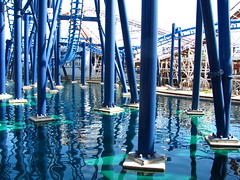 as those that come to ride the coasters are likely already familiar with Nemesis or one of the other better inverted rides scattered throughout Britain. An arbitrarily reduced capacity (eight cars per train instead of the customary ten, plus only one train operation) still meant this had one of the longer waits in the park, if only for the amount of time it took to wait for a dispatch to be made so it could get back to the station. I can’t criticize management for putting this thing in, in retrospect it’s such a logical fit it seems inevitable. But there’s not much joy in such keen rationality, is there? Praise isn’t deserved for simply filling in the correct answer in the black space; it’s deserved when an entirely new way of answering an old question is imagined that never before even existed as a possibility.
as those that come to ride the coasters are likely already familiar with Nemesis or one of the other better inverted rides scattered throughout Britain. An arbitrarily reduced capacity (eight cars per train instead of the customary ten, plus only one train operation) still meant this had one of the longer waits in the park, if only for the amount of time it took to wait for a dispatch to be made so it could get back to the station. I can’t criticize management for putting this thing in, in retrospect it’s such a logical fit it seems inevitable. But there’s not much joy in such keen rationality, is there? Praise isn’t deserved for simply filling in the correct answer in the black space; it’s deserved when an entirely new way of answering an old question is imagined that never before even existed as a possibility.
Meanwhile, Bling only wishes it could get off with such faint praise. A tacky carnival ride dumped in an empty lot near the Big One’s lift hill, it somehow manages to upstage a 200 foot tall purple mountain jutting over the sea as an even bigger eyesore. A tip for planning and development departments: just because your park’s appeal is its colorful spontaneity not grounded in any one style, doesn’t mean you can add a ride that’s not at all grounded to the dirt it’s built over without it looking cheap and out of place. The Zierer “Star Shape” flat ride (sort of a mutant Top Scan and inverting pendulum) accomplishes very little with its ride program, mostly the seats just rock back and forth very rapidly in an aggressive bid to reduce all of its riders to vomiting derelicts within five minutes. Thank God that 2010 was its last season scheduled to operate before being removed, perhaps the smartest decision by the current management in a long while.
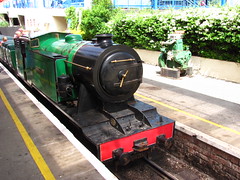 I’m getting rather depressed discussing all the various improvements seen around the park over the past decade and finding the best is the choice of removing a ride, so I need a return to the basics. The Pleasure Beach Express promised good things, a miniature railroad dating back to 1934 with a fantastically detailed vintage steam engine at the lead, and a route leading though several improbably tight spaces threaded between and under existing rides and attractions. A must-ride, if only because it affords the opportunity to see several Pleasure Beach landmarks from angles not possible anywhere on the midway. The photo slideshow below will speak for itself.
I’m getting rather depressed discussing all the various improvements seen around the park over the past decade and finding the best is the choice of removing a ride, so I need a return to the basics. The Pleasure Beach Express promised good things, a miniature railroad dating back to 1934 with a fantastically detailed vintage steam engine at the lead, and a route leading though several improbably tight spaces threaded between and under existing rides and attractions. A must-ride, if only because it affords the opportunity to see several Pleasure Beach landmarks from angles not possible anywhere on the midway. The photo slideshow below will speak for itself.
Before heading out the entrance for day one, the last ride to check off is the S&S turbo drop tower named Ice Blast (I think some soft-drink sponsoring might be involved as well). With no distinguishing characteristics between this installation and every other tower ride protruding like splinters across the earth, I will continue the tradition of telling unrelated jokes (some more philosophical than others) in the place of a review. This one goes like this:
Gil is casting his line along a beautiful stream when he snags a gorgeous twenty-pound salmon. But just as he is hauling it in, he has a massive heart attack.
When he comes to consciousness, he sees that he is lying beside an even more beautiful stream and that it is teeming with salmon. Next to him is a state-of-the-art rod and reel. He grabs it and casts his line. Bingo! Gil immediately catches a spectacular thirty-five pound salmon and reels it in. He feels terrific. He casts again, and once again he instantly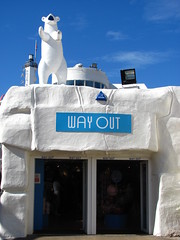 snags a fantastic fish. On and on he goes, the glorious fish lying in a long row on the bank behind him.
snags a fantastic fish. On and on he goes, the glorious fish lying in a long row on the bank behind him.
But as the afternoon wears on, Gil realizes he’s no longer fishing with his usual enthusiasm. In fact, he’s starting to feel bored.
Just then, he sees another man walking along the stream bank toward him. “So, this is heaven,” Gil calls to the other man.
“You think so?” comes the reply.
_
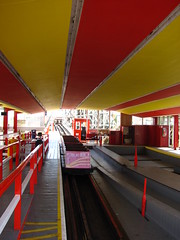

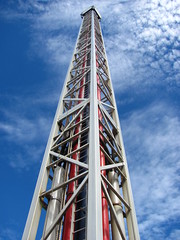
Comments